Published: 2nd November 2023 | Author: Tanya Russell
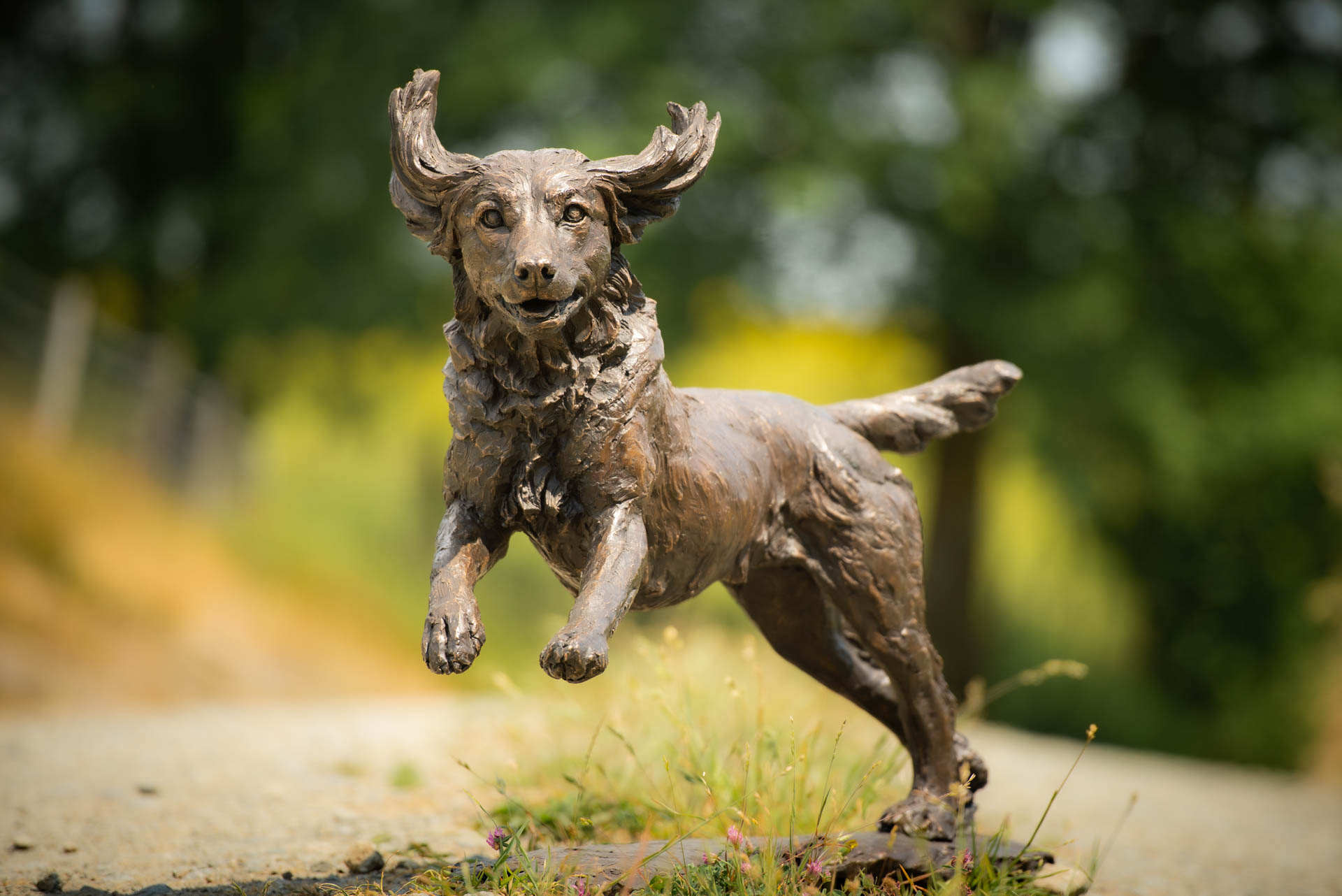
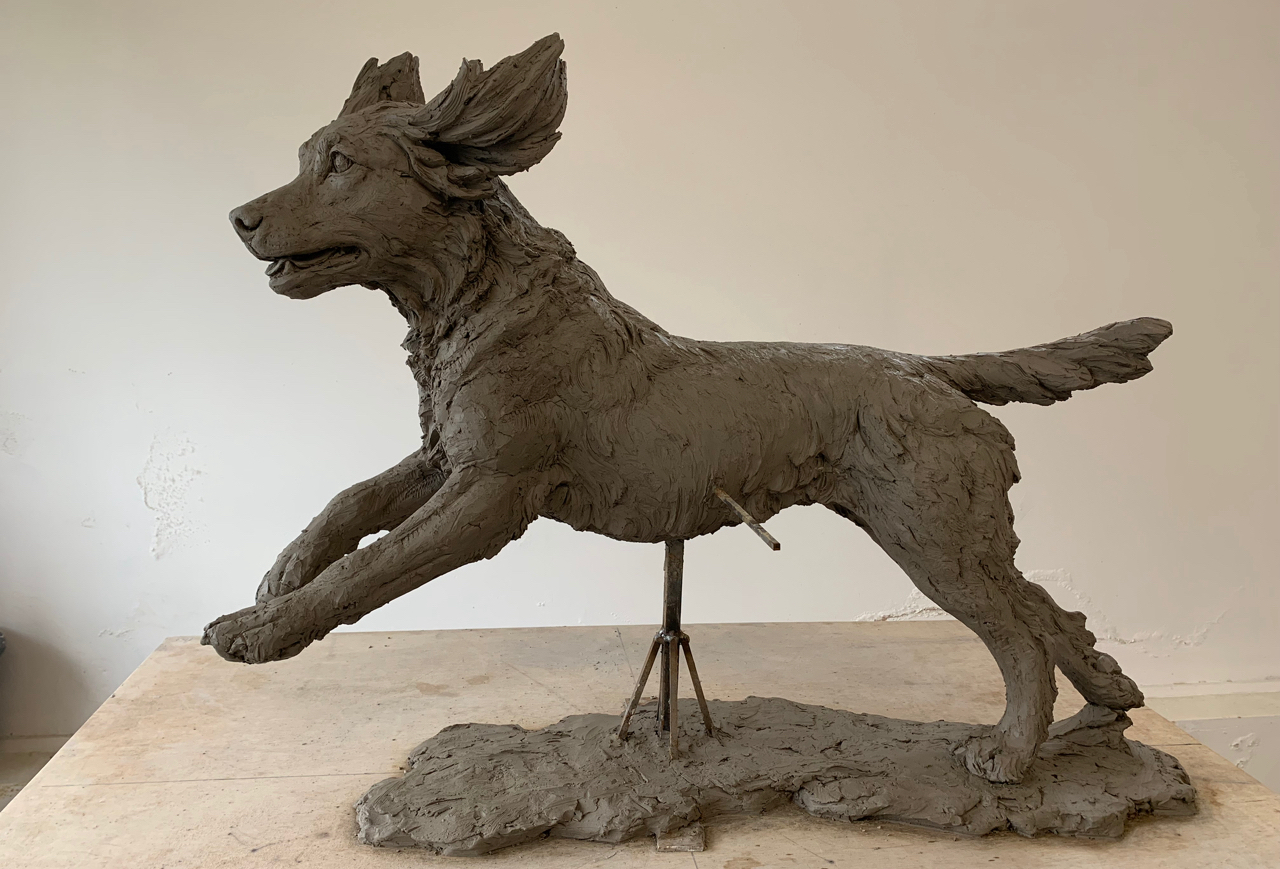
Common questions about bronze dog statues
- Making a custom statue of your dog: Called a commission, you can expect a custom bronze dog to cost upwards of $7,500 USD or £6,000 GBP. It can take up to 15 months to finish a custom dog statue and the time and price varies a lot depending on the statue size, the material, the artist and their experience level. My prices are here. If a custom bronze dog statue is too pricey, there are some tips and alternatives below.
- Are bronze statues different colors: Statues in bronze metal and ‘cold cast’ bronze resin can be many colors, including classic bronze, white, black, golden or multicoloured. But the reason why classic bronze is most common is because other colours change much faster outside in the weather. Indoor dog statues have much more leeway in their colouration. But colouring bronze well is a real skill, and it can make your dog sculpture more expensive to purchase.
- How heavy is bronze: A solid bronze ingot 11 inches long, (nearly as long as one ruler, or the size of a large carton of milk), weighs 25 lbs or 11 kgs. A labrador-sized bronze dog statue takes two strong people to lift, and a bronze labrador portrait head can be lifted by one person. Foundry bronze statues are cast hollow, except in the smallest sized, because they weigh a lot, but also because bronze deforms when cast too thick. This bronze weight affects how easy your statue will be to move around your home or garden, and it also determines how it will be delivered to you. For comparison a labrador-sized statue made in a lighter material, such as ‘cold cast’ bronze resin, can be lifted by one person.
- Can bronze go outside in the garden: Bronze is so famous and traditional because it was one of the only materials that lasted well outside in the weather. Dog statues can last hundreds of years outdoors, and the primary issue you will see is gradual colour change, which can be slowed, and also returned to the original patina. The bronze metal is extremely hardy, putting up with both extreme cold, extreme heat, high wind, water freezing, and very wet weather. It does not do well submerged in salt water or chlorinated water, where ‘cold cast’ Bronze Resin performs better, though this more affordable material is far surpassed Foundry Bronze metal in all the other extreme conditions.
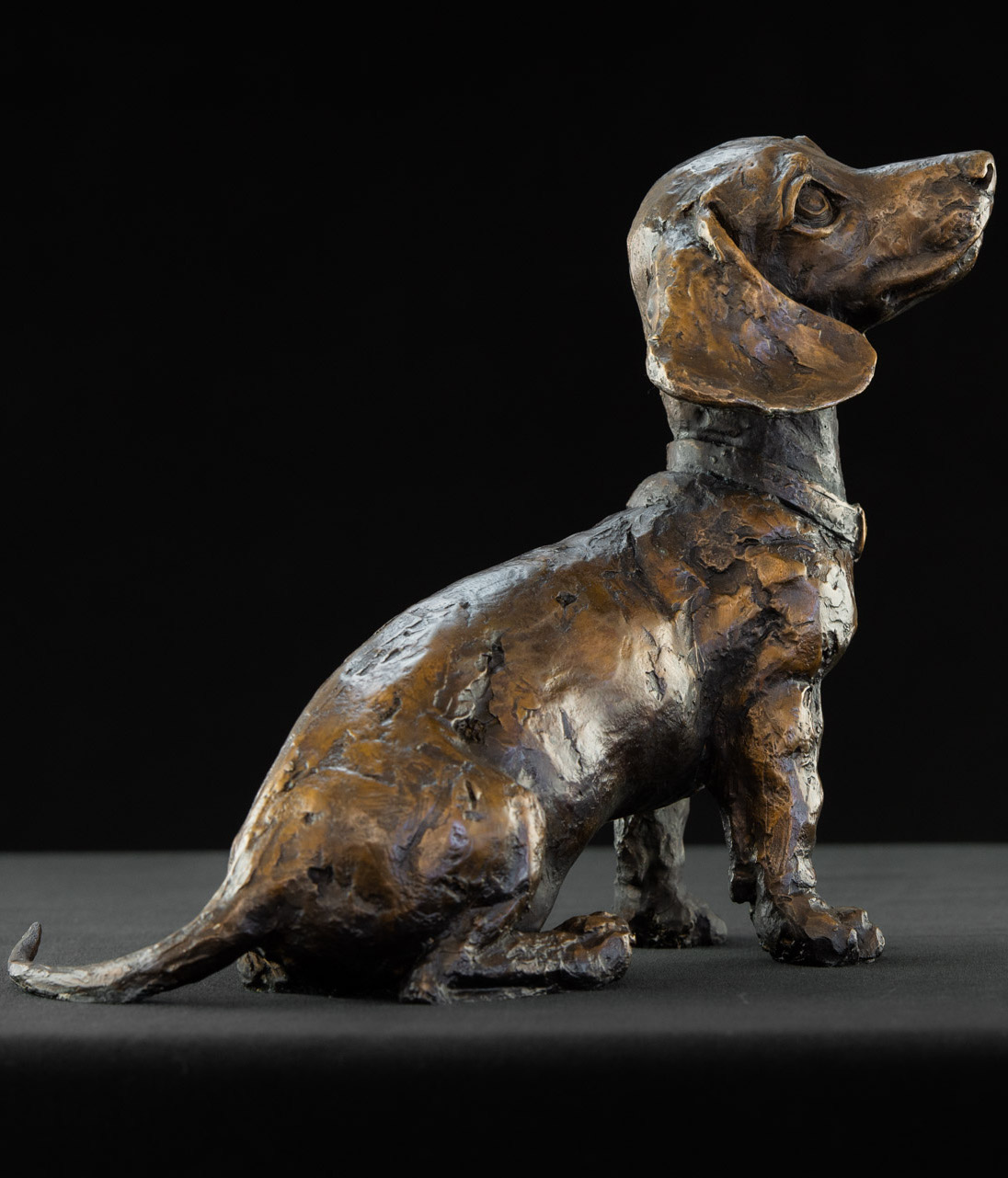
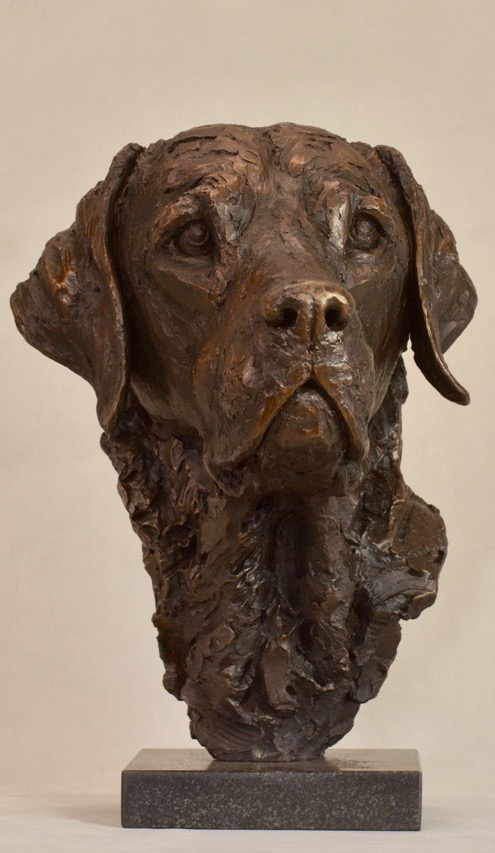
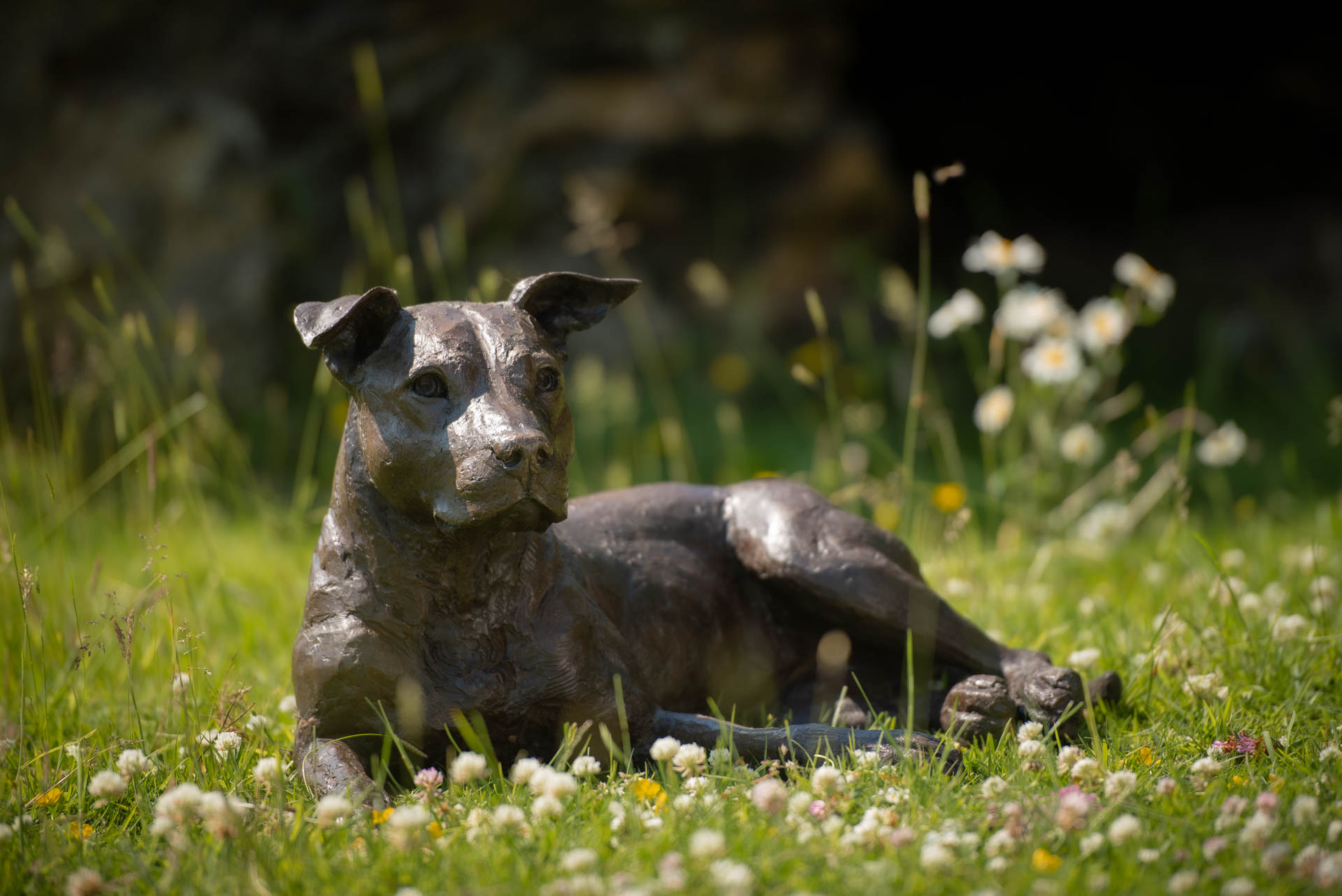
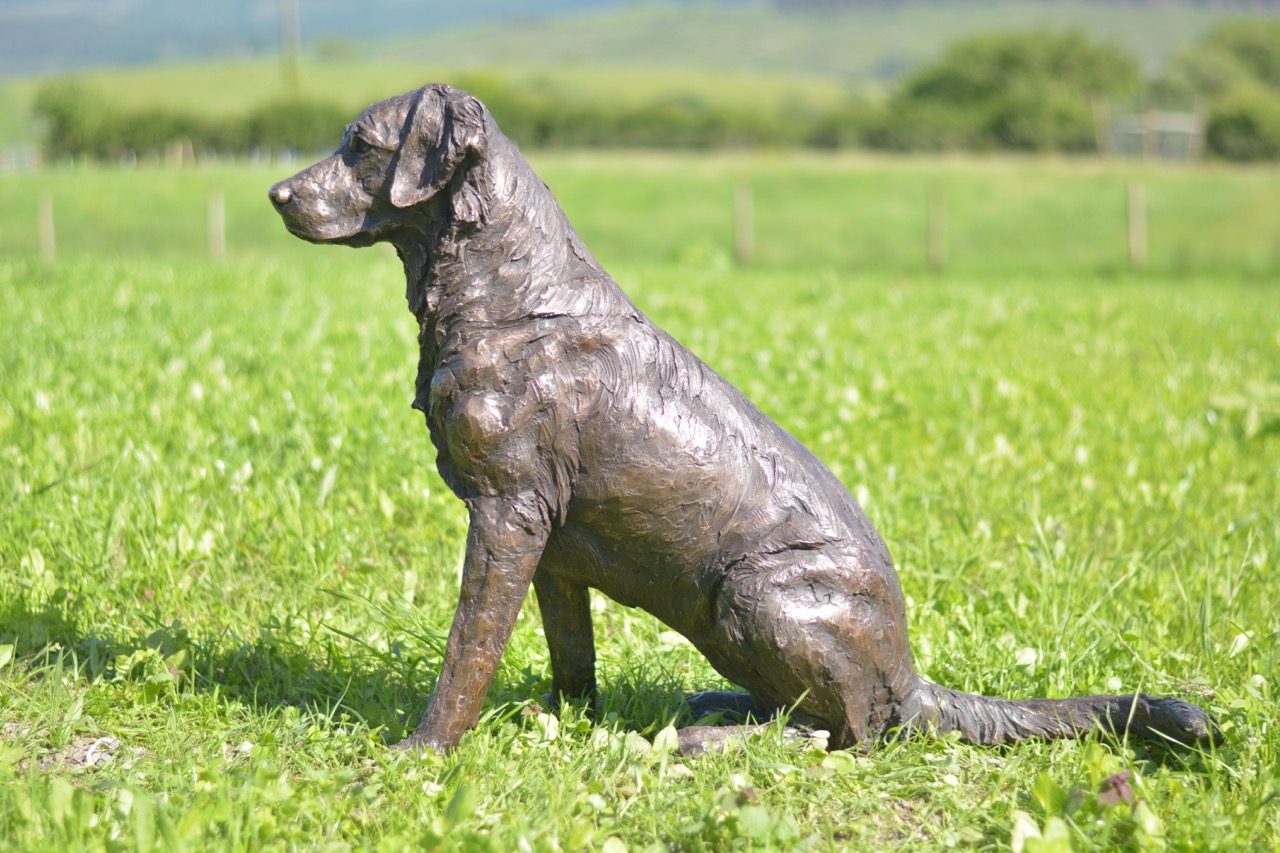
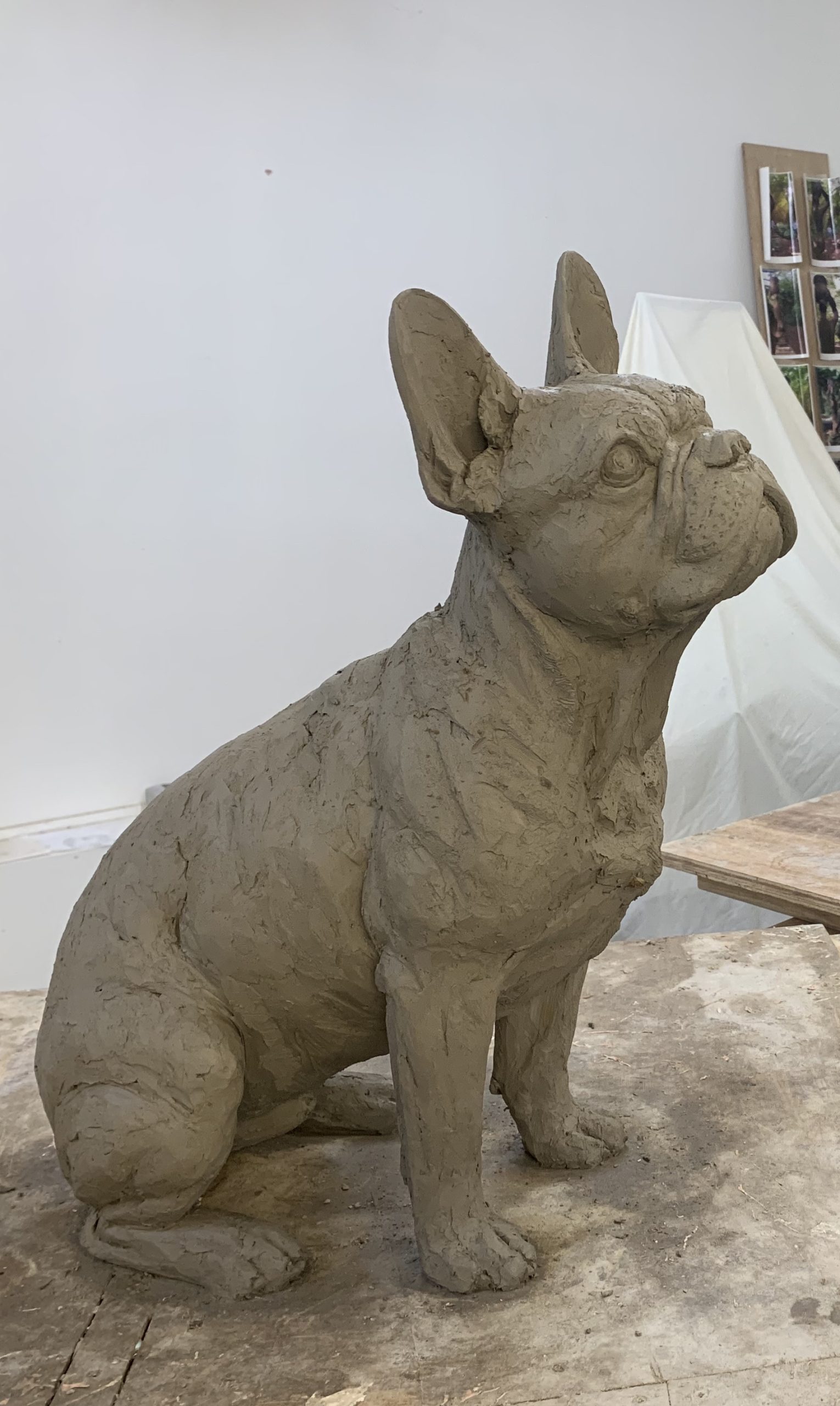
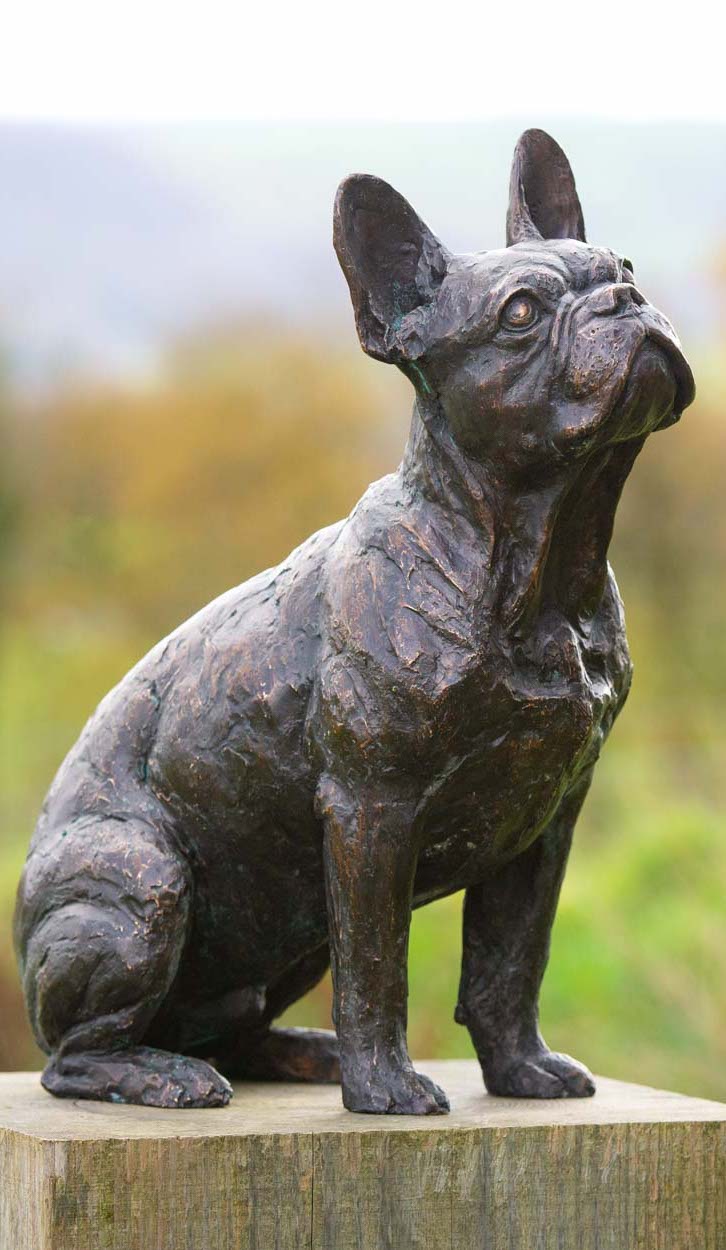
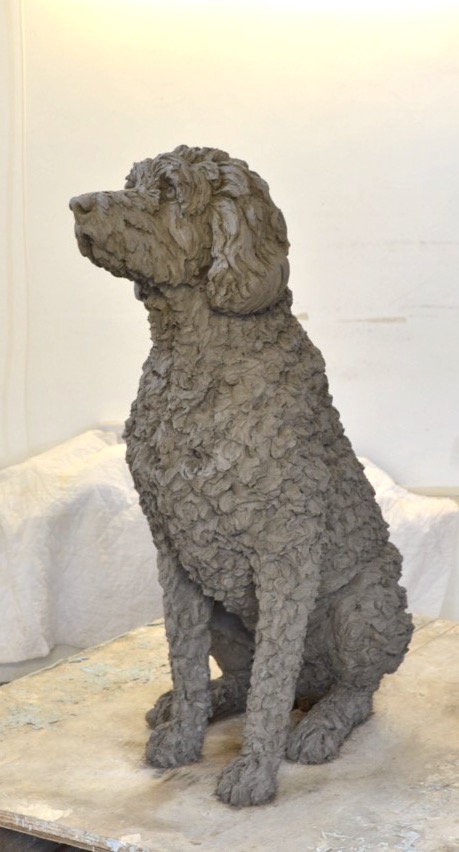
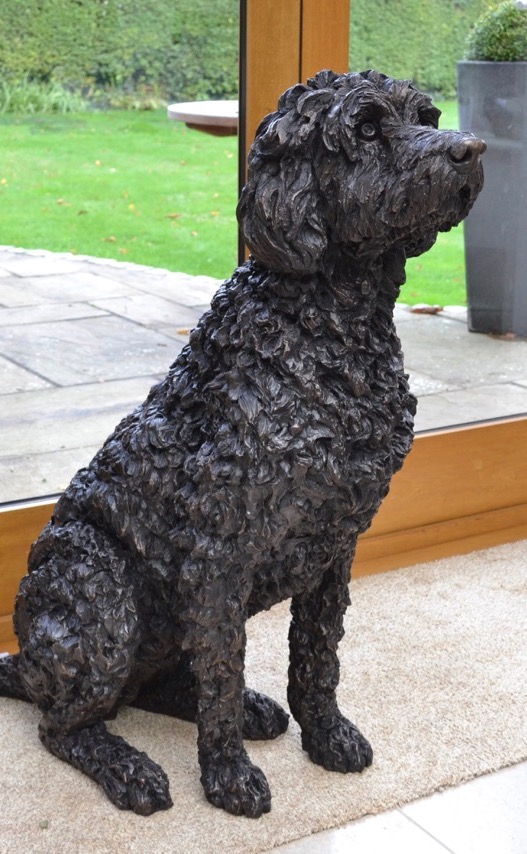
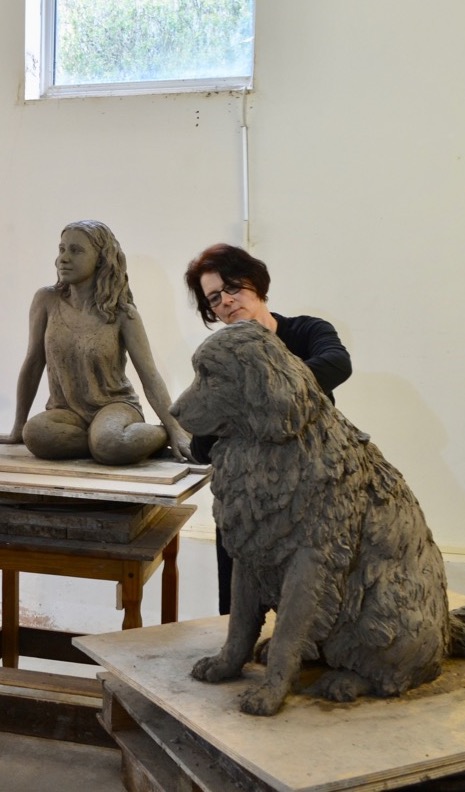
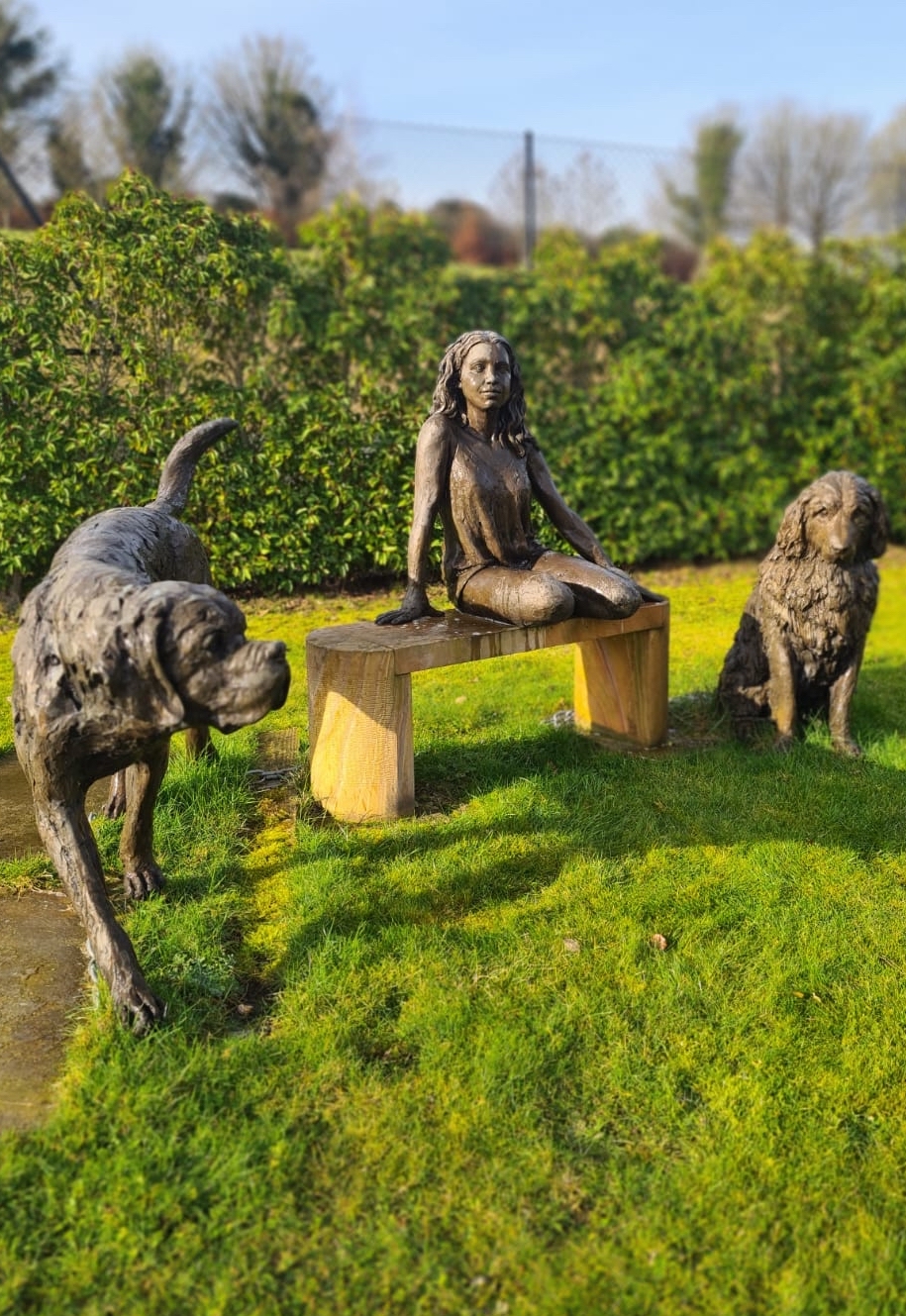
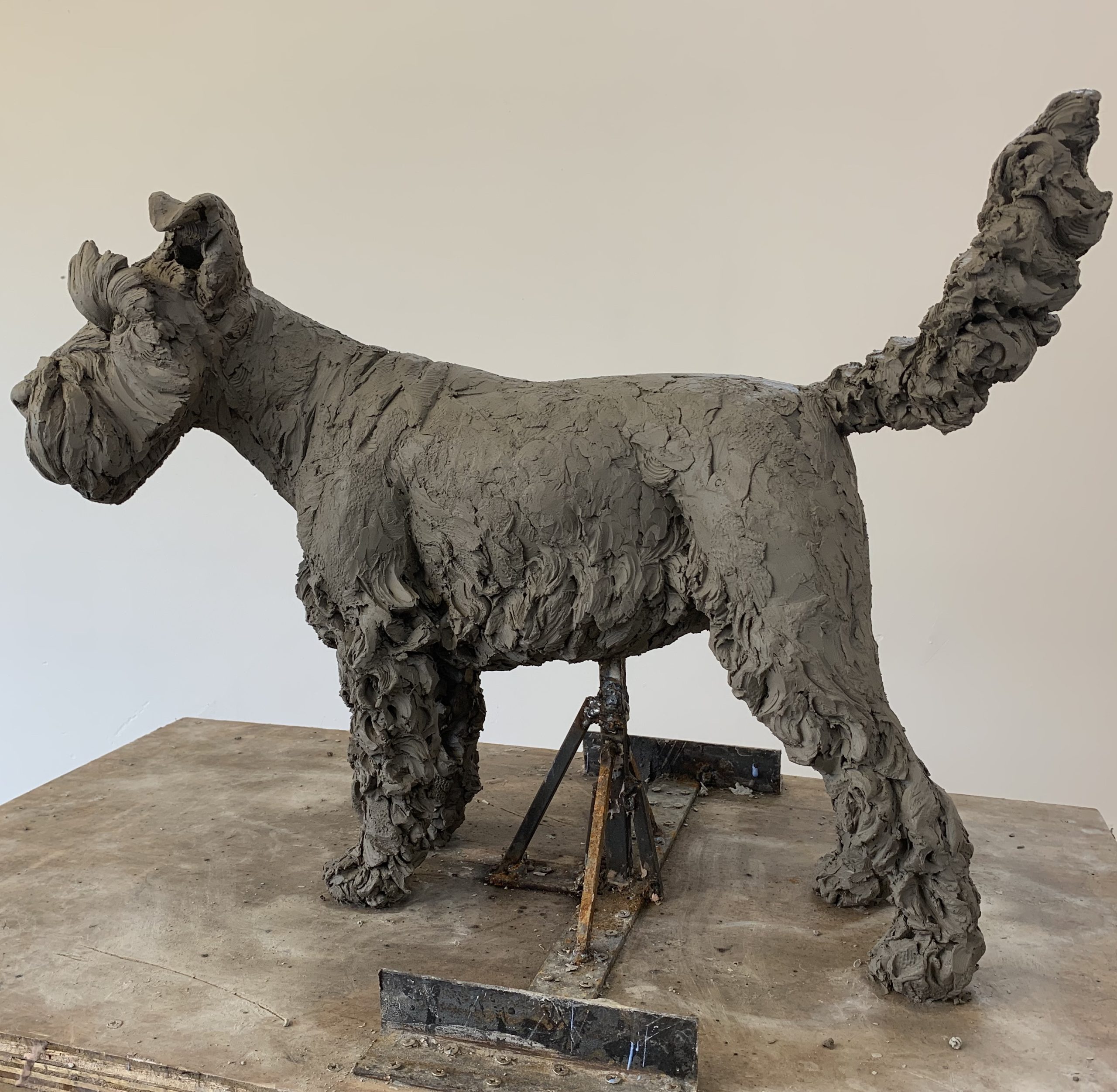
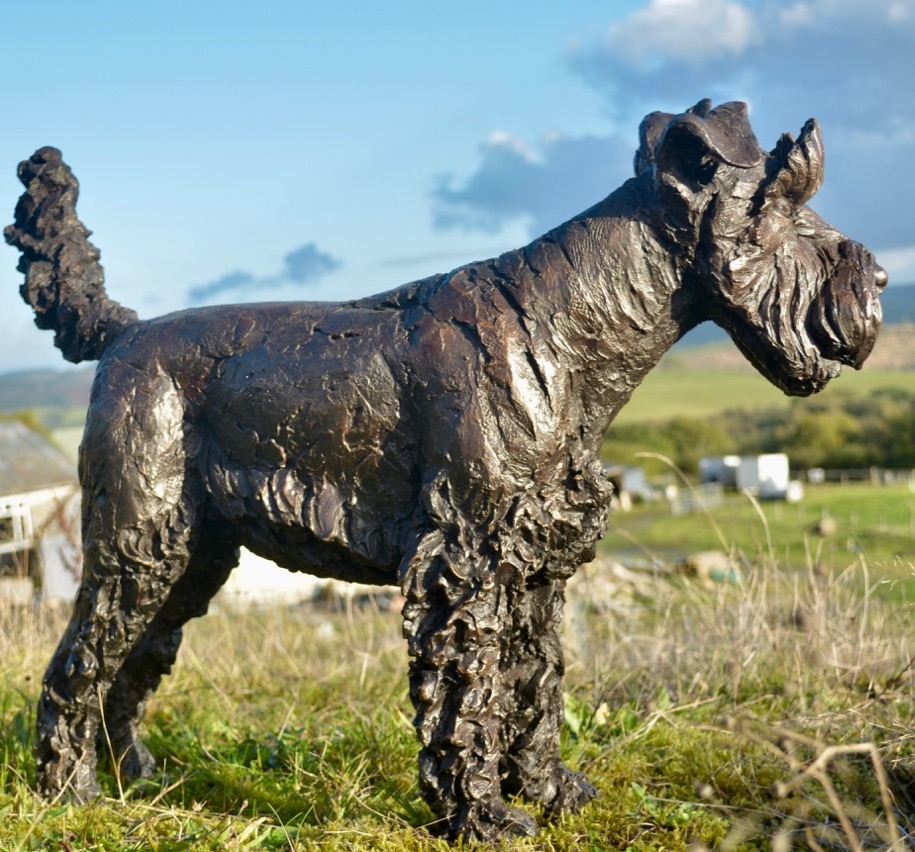
When commissioning a custom sculpture of your dog
- Decide if you want a statue that looks like your dog: Tell the artist what you can about your style requirements. Ask yourself, ‘do I want the statue to look as similar to my dog as possible?’ If so, then what age should your dog be sculpted at? Your memories of your dog will be from multiple important times in your lives together. Ask yourself what you’d like to capture about your dog’s character and energy. This will help determine the pose the dog will be sculpted in, such as sitting, running, lying down or jumping. It will help with the conversation about the expression that you might want on the dog’s face. Most dog statues are quite traditional, in that they are very representational – but you might want to consider a less representational mark-making style, which captures more of the dog’s vivacity at the expense of faithfully sculpting tufts of hair. You might even want to consider a semi-abstract or abstract dog statue, which might actually create a more artistic and emotional portrait of your dog. Abstraction is risky, in the sense that, if you ask for the statue to look like your dog you know what you are getting. However, abstraction absorbs a lot of the artist’s personality and style too, and you may end up getting more than you bargained for in a statue that expresses your dog more perfectly than its physical form can.
- Collect all the photos and videos that you can: Some of the ‘worst’ ones are actually the most helpful to a sculptor, because they may show angles or details like the backs of paws and the underside of tummies and heads that the sculptor wouldn’t see in your ‘good’ photos, which are all taken at the same angles. You can’t fit many large photos onto an email, but a sculptor can provide an online photo dropbox that you can upload loads of high resolution photos and video to.
- Consider your budget: A larger budget can get you an experienced sculptor and a statue made in a long-lasting material, like bronze. My prices are here on my dog commissions page. But smaller budgets can still achieve a sculpture of your dog in different materials such as those here on Etsy. And two dimensional work like painting and drawing can be a beautiful and often more affordable option too. If you receive a quote that is too high, you can ask some follow-up questions to see what could make your sculpture more affordable. The sculptor will usually quote an edition length, and offering a larger edition can decrease the price of your sculpture. Another way to achieve a cheaper price is to ask the sculptor if there is a pose, or size, or style that would help them make your dog in for less. The artist may be aware that they are more likely to sell the edition copies of your dog is sculpted in a certain way, and could give you a discount if they can advise you on the cheapest way to do it for you. The most helpful consideration for owners of crossbreed dogs, or non-breed standard-looking dogs is, that the sculptor can make some small adaptations to your dog statue in the clay, after your approval, to make the edition copies more saleable. For example, if your basset hound cross has short ears, and all breed standard bassets have long ears, your quote will be more expensive than it would be otherwise – because the artist won’t be expecting to sell the edition. You could get a better price if you say, ‘I know my dog’s ears aren’t breed standard, but I’m happy for you to make two sets of ears’ (if you are commissioning a ‘cold cast’ bronze resin), or ‘I’m happy for you to amend my ears to the correct length in the wax’ (if you are commissioning a foundry bronze dog statue). Your statue could be both unique and cheaper, while the artist will get an edition of a breed standard dog, that can be sold to other buyers, allowing them to give you a better deal. If the statue of your dog remains out of reach, there is nothing stopping you from approaching another artist – younger, less experienced artists, or artists who haven’t made a lot of that type of sculpture might give you a really good price.
- Think twice about your timeframe: it takes a long time to make a statue of your dog, and a good sculptor is likely to be booked up with commissions for some time. If you want it for a birthday coming up soon, consider aiming for the birthday next year, for example. If you are doing it for an anniversary present, then ask what the artist can provide you which you can gift on the special day that will let your partner know about the bespoke dog sculpture you are having made for them.
- Can you trust that the sculptor is going to deliver?: having a bespoke sculpture made of your dog relies so much on the individual artist’s reliability. It can go wrong in many ways. The artist could deliver your dog statue late, or worst case the artist might not deliver your bronze dog at all. There could be a conflict about payments, because your circumstances change and you can’t pay one of your deposits, or because the sculptor discovers they have underquoted for your dog sculpture and will make a loss. There might be damage during transportation, or the statue might be lost in the post. If your dog statue is in public, they might advise a weak material will be fine. So how do you decide if the artist you approach is reliable? It is an informed guess. Check to see what work they have made before, do they look experienced? Does any testimonial on their website look trustworthy and can you find any anywhere else, like Etsy? If based in another country, are they prominent there, or are you putting yourself at risk? Make sure you are paying a deposit and not the whole amount up front – a third, or at most a half is a common deposit size for a bespoke dog statue. Do you have the entire agreement with the sculptor in writing? Don’t rely on the phone for important communications! If you want to speak to them directly, send a follow up email to summarise the main points. Most sculptors are good people, but the best sculptors will prioritise their client’s interests if things go wrong.
- Decide if you want ashes placed in the dog sculpture: most statues can have ashes placed inside but you don’t want to mix the ashes into the casting material, as it can cause creation issues or weaknesses. All bronze metal dog statues are hollow, except the smallest ones. So they can accommodate either all the ashes (for lifesized dog statues), or a proportion of the ashes (for smaller pet sculptures). If you are having a very small dog sculpture made you may want to think about mounting on a box on the grave instead. Other statue materials, like ‘cold cast’ Bronze Resin, can have a compartment introduced during the casting, which you can place the ashes inside. But remember to ask in advance! As for either material you will not normally be able to place ashes into your dog sculpture without it being made specially with that in mind. If you are providing the ashes to the sculptor by post, look up whether your country or theirs has rules about posting ashes. If you are looking for a container to put the ashes into for postage, search online for metal canister urns for larger amounts of ashes, or for cylinder ashes pendants or miniature metal urns, for small amounts.
- Other special requests: might include a base or plinth for your dog statue, or engraving your dog’s name onto the bronze statue, or onto a sculpted dog collar. When commissioning a dog memorial sculpture that you intend to place on your pet’s grave, you should thing about where you expect the sculpture to go, so you can ask about the appropriate fixings. Your dog statue can be provided with fixings for mounting it on hard a hard surface like a grave marker, or it can have fixings for keeping it stable or secure when placed on soft ground, such as turf.
- How to get the size of your dog statue correct: with life-sized dog sculptures, size is really important, and taking measurements while you can will help the artist get your statue right. If your dog is alive and the artist lives in the same country as you, they will want to arrange a visit to take measurements and photographs of your dog. Their measurements will normally be more accurate than the ones you can take, if they have made a lot of dog statues, they’ll have measured dogs many times before. The best way to help during a visit is by having your pet’s favourite treats and toys ready as distractions during the sitting. Do not walk your dog just before the visit, unless you want their tongue hanging out in all the photos! Measuring and photographing might take an hour, or longer. Now, if your dog has passed away, or if a visit to see your dog is not practical, then photos of them next to people and other measurable pieces of house furniture will all be useful. If your dog is alive, taking your own measurements now (seriously, now) in the pose you’d like them sculpted in will provide some really helpful information if you ever go ahead with a commission. Have you tried yet? Isn’t it hard! Here is a page that talks about how to measure your dog for a sculpture commission. Hopefully, it helps!
- Viewing your dog statue while it is being made: ask the sculptor how you can ensure you like the sculpture they’ve made of your dog. If you are able, visiting them to see the work in progress is the best way to ensure you like the sculpture. If you can’t visit, ask for photos and videos of the clay. And then ask for more after the amendments you requested have been made. The best time is usually near completion of the clay, which is the first stage of the process. After that is too late, as the details of your sculpture are usually set in stone (by which I mean ‘in the mould’, or ‘in the bronze’!) A good sculptor will be happy to discuss amendments with you. Amendments like face shape, coat length, eye and ear details, and limb arrangements are probably changes they can make without too much trouble. Be aware though that if you want them to change the size, that could be a bigger problem! They may have to resculpt the whole thing, so to avoid this being a problem, try to talk about how amendments will work in advance.
- If you can’t afford a custom sculpture: there may still be a dog statue that looks like your pet. An existing dog sculpture costs a lot less than one made specially for you, so if you have received a quote that is too high for making your dog, ask the artist if they have anything that looks similar to your dog and send them a picture. If you own a labrador, you are in luck! Not only is the breed very popular, so I’ve sculpted them many times – but dogs of that breed are also known for looking reasonably similar to one another. You can ask a sculptor if they could make an amendment to an existing dog statue, to make it look more like your dog. However, normally the answer will be no (because the statue will be made of a hard material, which cannot be altered). Your best bet for an alteration despite this is if you only want a tail to be shorter, or would like an existing male dog statue to be made female, or vice versa. This is easier. For more intrusive changes than these, you would have to pay for the more expensive Foundry Bronze metal material, because with that material there is a mid-point in the casting process where the dog is made in wax. This wax is soft, so the sculptor could make some alterations for you. The scale of acceptable alterations and price will vary according to the individual artist. Lastly, if you have received your quote for a custom dog statue and it was too high, you should check whether you enquired indirectly through a gallery, or through a website with lots of artists’ work on it. If you did, the price you are paying has been artificially inflated, because the gallery or website is charging the artist a percentage for referring you. This might be between 10 and 30 percent. The sculptor won’t be able to make you something at a lower price now, because they have an agreement with that gallery or website. But if another person went to that sculptor directly to ask for the same dog to be made, the quoted price would be lower.
The details matter when shopping for dog statues
Modelling and casting is a method of sculpting that allows a sculptor to produce multiple robust sculptures, often for outdoor use, but still create an artwork with a very, very high level of detail. The original material used is soft – clay or wax. Because it is soft, the dog statue can be sculpted with very great attention to detail. It can capture the individual mannerisms and marks of the artist. But that clay or wax would be destroyed instantly by the wrong temperature of weather. Creating a rubber mould of the original clay allows the dog sculpture to be reproduced in a harder material, so it lasts a long time, outdoors or in. Most other statues made of hard materials cannot achieve the same visual effect because they cannot be extracted easily from the mould, and they do not work well with fine detailing. Concrete is one of the most common examples. Think how much you would have to pay for an orginal marble sculpture! Or consider how hard it is to create complex three-dimensional shaping or detailing when fabricating a dog from steel.
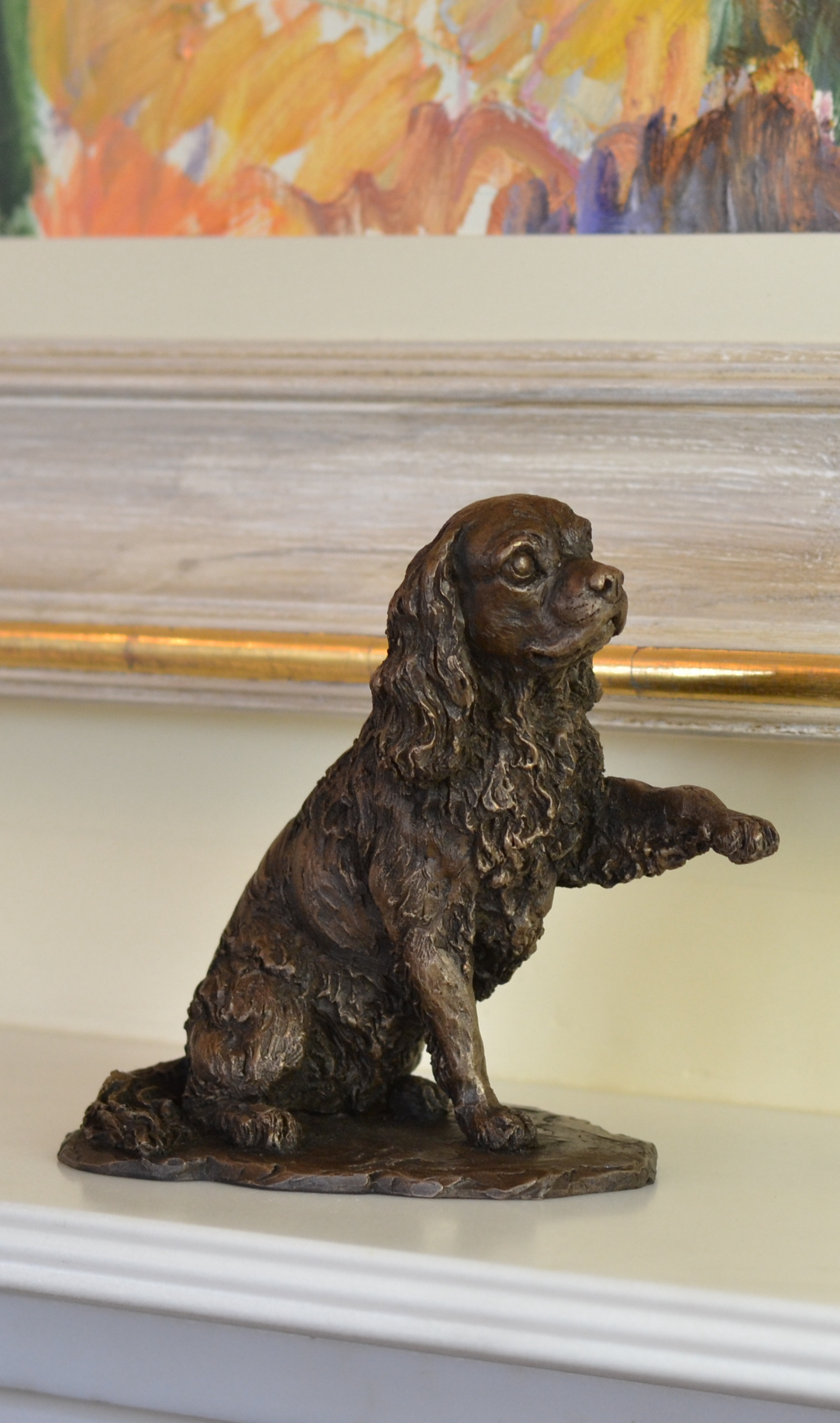
ABOVE & BELOW RIGHT: Casting dogs in foundry bronze metal or bronze resin can achieve more detailing, and capture more of a dogs character. Few outdoor materials can match the level of detail that can be reproduced, down to the lines in the sculptor’s fingerprint!
BELOW TOP: Other casting materials, like concrete, struggle to reproduce details, and often can’t be used for dog statues with space under the body.
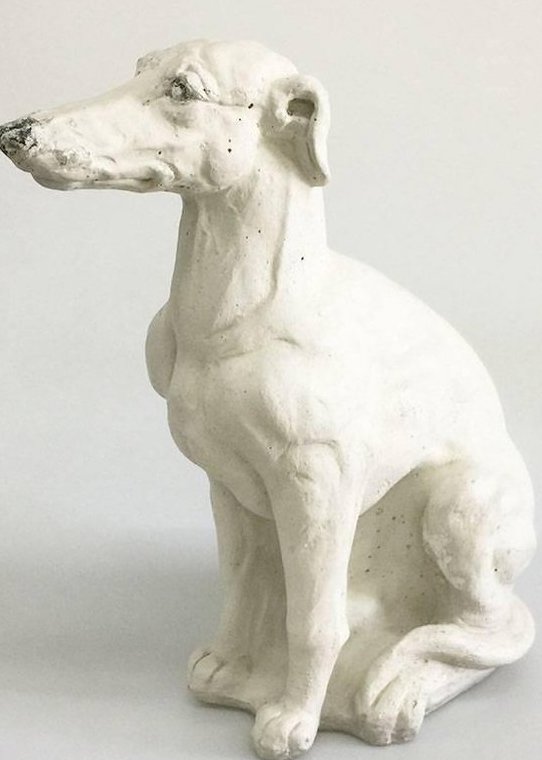
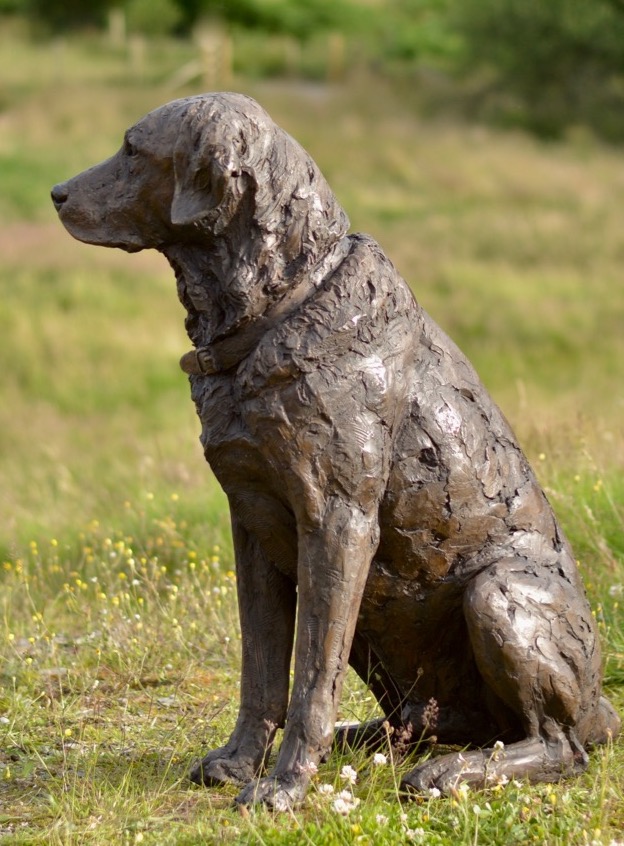
Explore Related Articles
ASTON VILLA F.C. unveils my Lion to celebrate their 150th year
Due to be unveiled in May, I have created a to scale clay, which is now being cast in Foundry Bronze metal
How to measure your dog in a Lying Down pose, for a customised statue commission
If you think you might want a statue in the future, it can be a good idea to take some measurements of your own dog. Here’s how to measure them in a lying down position.
Sculpture plinths, pedestals and columns for statues
Finding the right plinth or pedestal for your statue: including a list of suppliers, some examples of different type of pedestal, how to make your own a plinth, how to fix a statue onto a plinth.

Tanya Russell MRBS
Bronze Sculptor
Tanya Russell has become well known over the last 30 years for her life-like and vibrant animal sculptures.
Having apprenticed for 7 years with her parents, sculptors Lorne McKean FRBS and Edwin Russell FRBS and after practicing as a sculptor for a number of years, she founded the The Art Academy in London Bridge, now a thriving art college. She has completed many public and private commissions nationally and internationally.
For Tanya, her practice is not only about capturing the animals she sculpts with marks and movement. It’s about our relationships with those animals and their welfare.

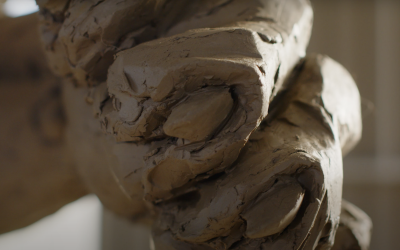
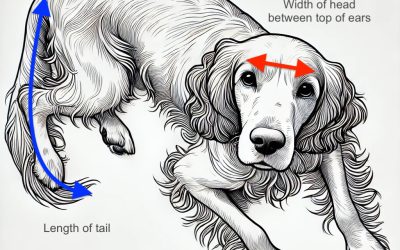
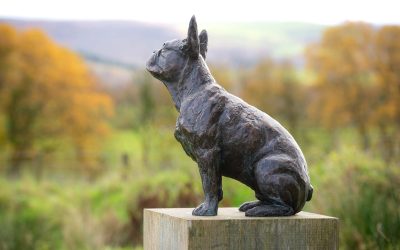
Follow The Artist
Keep up to date with Tanya's latest work!